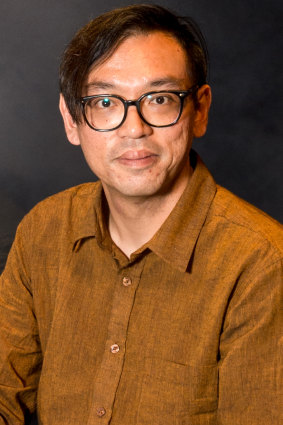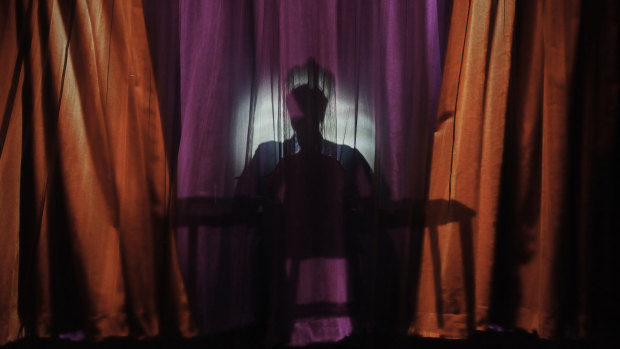By John Bailey
Before spycraft was mostly email, there was a period when nothing seemed more glamorous than espionage. It might be that so many of the great novelists of the period – from T. E. Lawrence and Ian Fleming to Graham Greene and John Le Carre – had themselves been spies. It might also be that espionage itself is all about creating fiction, fabricating identities and plots that dazzle and distract.
One of the most fascinating yet little known figures of clandestine politics was a man known as Lai Teck. Leader of the Communist Party of Malaya in the 1930s and ’40s, he was also a triple agent working simultaneously for the French, British and Japanese secret services. With at least 50 alternate identities now uncovered, he’s the kind of figure who erases the distinction between reality and fiction, and a work coming to Melbourne in March offers a portrait every bit as elusive.
There’s a conventional way of staging a biographical work such as this – monologue, mostly chronological, delivered in the first person. That’s nothing like The Mysterious Lai Teck, a theatrical experience every bit as manipulative, obfuscatory and surprising as its subject.
Singaporean artist Ho Tzu Nyen’s connection to Melbourne goes back to the late 1990s, when he studied the multidisciplinary Creative Arts course at VCA (“I majored mostly in sculpture and photography, which I don’t do at all now.”) His practice is equally cross-artform, inclusive of installation, film, sound and live performance.
The Mysterious Lai Teck has been described as all of these, though Ho says that to him the piece sits squarely in the framework of theatre. “The fact that you have a stage, you have a kind of human presence on stage speaking, that seems to me to tick the boxes of what constitutes theatre in the most basic sense.”

Ho Tzu Nyen: ''This idea that evil or the mastermind doesn’t have a physical presence ... was a big part of how I conceived of this work.''Credit: Penny Stephens
He brings echoes of two other artforms to that theatrical framework, however: the intensity of the experimental music concert, and the seductive trickery of cinema.
“The kind of music performances that I like, you feel the music with your body. I’m usually so immersed in these performances that I lose track of time.” (Numerous reviews have said the same of The Mysterious Lai Teck.) “For some types of music you feel a lot of low frequencies that are sculpted, that almost feel as though they have a physical impact. Your whole body is an ear. You don’t just listen with your ears but your entire body. That appeals to me.”
For the work’s cinematic aspect, Ho describes his fascination with the way early cinema featured a speaker concealed behind a screen, and how this simple dynamic has rich allusive connotations. He cites the 1933 Fritz Lang film The Testament of Dr Mabuse, in which “the evil criminal mastermind Dr Mabuse is always speaking to his henchmen from behind a set of curtains. At some point the protagonist pulls them open and instead of a real human finds just a machine, a loudspeaker, and a cut-out silhouette of Doctor Mabuse.
“This idea that evil or the mastermind doesn’t have a physical presence but is a voice that is infinitely reproducible was a big part of how I conceived of this work.”

Ho Tzu Nyen’s The Mysterious Lai Teck. Credit: Park Suhwan
The Mysterious Lai Teck features a human speaker behind curtains, which act as both screen and frame. Just as Lai Teck’s true identity was hidden in a metaphorical hall of mirrors, so too is the nature of the work’s narrator always retreating from the audience’s grasp.
Unlike in many Western countries, in Singapore and Malaysia there’s very little historical awareness of the political left. “The history on the whole is very little known because communism was made illegal in many parts of South-East Asia. It’s already a very underground history,” says Ho.
The most famous figure is Chin Peng, who brought the region into open conflict with British colonial powers, sparking what became known as The Emergency. Less familiar is Lai Teck, who handpicked Chin Peng to be his successor as leader of the Communist Party.
It seems impossible today that such a high-profile figure could be a triple agent who travelled under dozens of false identities and betrayed nearly everyone who entered his life.
“This is another reason why staging the work not as a straight theatrical show makes perfect sense,” says Ho, “because Lai Teck as a triple agent must have been an amazing performer. To be a spy or a double agent, the performance required is a different type. It’s related to performing on a stage but it’s something else as well. You need a certain alienation from your own interior.”
Ho quickly realised that capturing the truth of a figure who was perhaps a fiction even to himself was a paradoxical task. “He was a man who produced versions of himself, so there is no sense of getting closer to the real Lai Teck.”
To get around this, he delved deeply into the historical context from which his subject emerged. Lai Teck grew up in Vietnam under French colonial rule. Ho researched the history of this era in the late 19th and early 20th centuries, and read novels written by people of Lai’s generation. What he found was a collision between classical Vietnamese culture under Confucianism and a host of new ideas including nationalism, communism, social Darwinism and French Catholicism.
“To be alive in Vietnam at that time was to always be exposed to this multiplicity of contradictory ideas. That actually gave me some kind of perspective, to look at this multiplicity that I imagine must have been a very big part of Lai Teck.”
If Lai Teck can’t be reduced to a single narrative, Ho suggests, that’s because the history of the region that spawned him can’t either. “To think about Lai Teck’s biography in his historical context is to look at the history of South-East Asia as a whole. He is for me almost a condensation or crystallisation of South-East Asia’s historical experience of being pulled in all directions by all types of forces and ideologies.”
Ho has been careful not to create a work that is celebratory of a figure who was deeply problematic, but he admits this era was a romantic one for the world of spycraft. It stands in contrast to the aftermath of the Cold War, in which espionage became bureaucratic, and to today’s whistleblowers, who no longer even work for nation-states.
Ho has his own theory as to why the popular image of 20th century espionage was so enticing, and it’s to do with those spy novelists who were also spies. “People involved in espionage are of course sworn to secrecy and despite the great adventures that they’ve dedicated their lives to ... they’re unable to reveal what they’ve done. Sometimes writing is this method of leaving traces and telling the world.”
It’s a pity, then, that Lai Teck’s only fiction was his entire life.
The Mysterious Lai Teck is at Arts Centre Melbourne, March 4-7. asiatopa.com.au